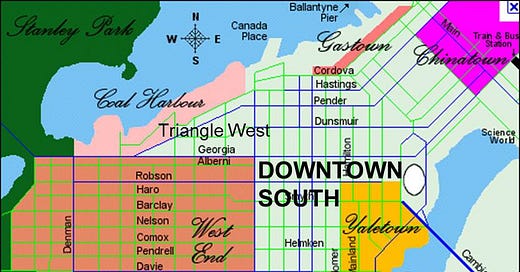New housing in Downtown South kept a lid on rents in the West End
When there's lots of new housing, older housing is less expensive
People sometimes ask when housing supply has ever pushed down rents.
Gordon Price describes how new housing in Downtown South in the 1990s kept a lid on rents in older housing in the West End. Lessons from the West End, July 2011:
I eventually realized that Downtown South was taking the pressure off my neighbourhood, the West End. As more units became available, they provided an outlet for newcomers who would otherwise compete with existing tenants.
And that’s what happened for two decades: the hundreds of new condos that were picked up by investors and rented out in Downtown South (and Triangle West, north of Robson) were giving an outlet for newcomers who could afford the higher rents. Upper-income renters left the 50s walk-ups and the 60s high-rises in the West End for lower-middle-income renters.
Downtown South and Triangle West also provided an alternative to West Enders who were willing to pay a bit more for something new (lots of electrical outlets and less dubious plumbing) – and that in turn kept a ceiling on rents, since landlords couldn’t raise rents on the ‘old’ beyond something that was ‘new.’ It even resulted in the West End uncrowding a bit in the 1990s, as those sharing units migrated east and north on the peninsula. The population of the West End grew hardly at all.
More
Downtown South Guidelines - approved July 1991.
Squeeze Play: lessons from a small space. Price spent a month living in a 290 square foot studio at 600 Drake, a 13-storey building with 200 apartments. 600 Drake was built by Concert Properties (previously the Vancouver Land Corporation, created jointly by the provincial government, the city of Vancouver, and 26 union pension funds), to provide smaller and cheaper rental apartments. Thesis by Craig Sidjak, 1995.
Previously: Class C apartments get cheaper when there's a lot of new "luxury" Class A apartments, the housing ladder



